Home Exercises Part 5: Squats
In this blog post, the fifth in our series scrutinizing popular home exercises, we are looking at squats. Is it a beneficial exercise, and how does it stack up—or not—against the principles of healthy posture?
Squats are a popular and effective exercise designed primarily to strengthen the quads, stabilize the knee joint, tone the glutes, and also work the back muscles.
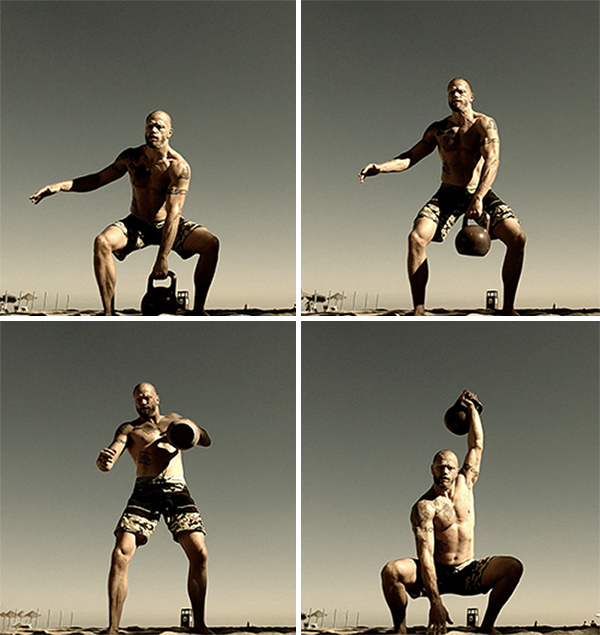
A squat is an essential baseline position for many athletic movements including this kettlebell snatch. Wikimedia
How low should they go?
Deep squats have become increasingly popular in recent decades, following a trend towards cross-training and exercise based on “natural movement.” Fitness and movement trainers have sought to emulate people in non-industrialized societies or traditional cultures who squat with ease, often for long periods.
Deep squats present challenges unless you grew up in a culture that routinely sits and squats on the ground. The challenge is not only in the muscles around the hips, knees, and ankles, but also in the bony part of the joints. When you are born your hip joint is made entirely of cartilage. By age 16, it is fully ossified. If you are not continually sitting and squatting low in your formative years the ossification pattern will not facilitate the angles necessary for squatting as an adult. It is therefore impossible for most westerners to squat low without tucking the pelvis and rounding the back, just like it is hard for them to sit crossed legged and relaxed.

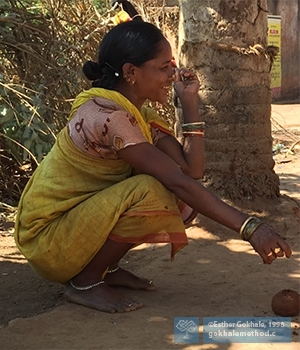
Even though her high heeled shoes reduce the angle of bend required to squat, the woman on the left rounds her back to squat. The Indian villager (right) can squat with a straight back. Unsplash
The benefits of standing/partial squats
For this reason I highly recommend partial squats, which are a safer option and offer many of the benefits of a full squat. They are also a perfect exercise to focus on and develop healthy posture.
Anyone who has ever done a fitness or yoga class may also know this exercise as Chair Pose. In some schools of fitness training, it is regarded as a foundational exercise. In traditional yoga it is known by its Sanskrit name, Utkatasana. Utkatasana translates as intense, powerful, fierce, difficult—you get the idea.
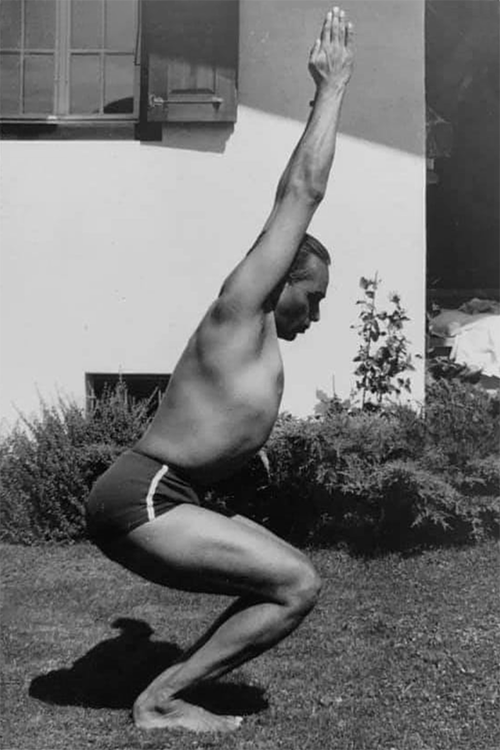
BKS Iyengar in Utkatasana, showing the challenge of the pose. Facebook
Squats can indeed be demanding. Lowering and raising your body weight into and out of the partial squat works the biggest muscles in the body (the leg and buttock muscles) hard, as they alternately contract (concentrically), and then release their length (eccentrically).
When you start training with squats you don’t want to go down too far—better to do a shallow, more open zigzag squat that eases you into the exercise. This avoids the risk of injury and you can increase the intensity and demands on your body by going deeper over time, as you get stronger and more flexible.
How to do a healthy squat
1. Preparation
To facilitate a healthy amount of external rotation in the legs and hips, softness in the groin and nestling of the pelvis, we recommend doing the paper clip stretch or figure four as it is also known. This is a good preparatory exercise before squatting, and, done regularly over time, will encourage a healthy nestling of the pelvis and alignment of the legs.
In this video I am demonstrating the paperclip stretch, which prepares the legs and hips for healthy squatting. Clip from Gokhale Method Open University video.
2. Start from a “Ready Stance”
A well-aligned standing posture is essential to maintain healthy form as you execute squats. The Gokhale Method teaches a position we call “Ready Stance” which aligns your feet, legs, and hips for correct movement. In this stance you will find the key characteristics of a squat, but in embryonic form:
- Stand with your feet hip width apart and pointing 10°–15° outward. Have a tiny bend at the hips and knees, as if you are about to play tennis or dance, bringing softness to the groin and back of the knees.
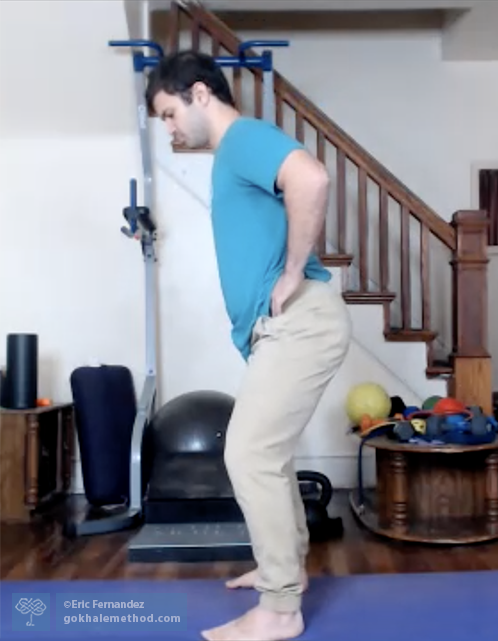
Gokhale Fitness teacher Eric Fernandez demonstrates the Ready Stance. It is like an ultra-mini squat.
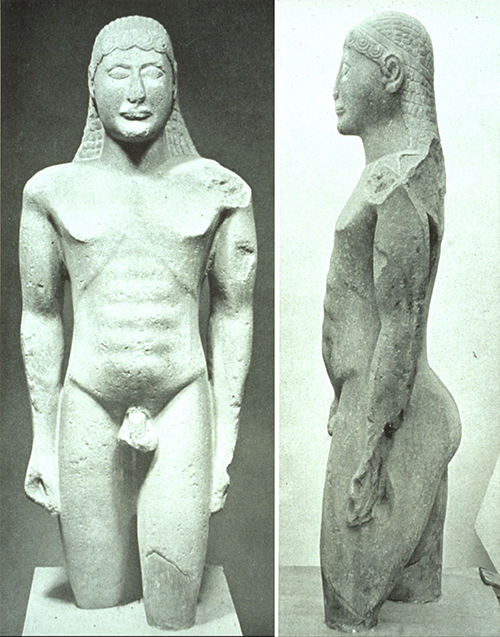
This ancient Greek statue captures the softness and depth you want at the groin even in everyday standing. To get there, take the Ready Stance and then stop short of locking your joints as you straighten up.
3. Going into a squat
- In the Ready Stance, rest your hands on the top of your thighs in your groin crease.
- Initiate your squat from your hips. As you fold deeper at the hips your behind will travel further back behind you.
- Your knees will bend in response to your bend at the hips. Keep them wide and pointing outward and your thighs out of the way as you bend.
- As you squat, allow your torso to angle forward at the groin as your pelvis rotates on your thigh bones. Check that your stance has a zigzag shape.
- Focus on maintaining the straightest possible spine by using your rib anchor.
- Keep your chin down. You want your neck and head to remain in the same orientation as the rest of your torso.
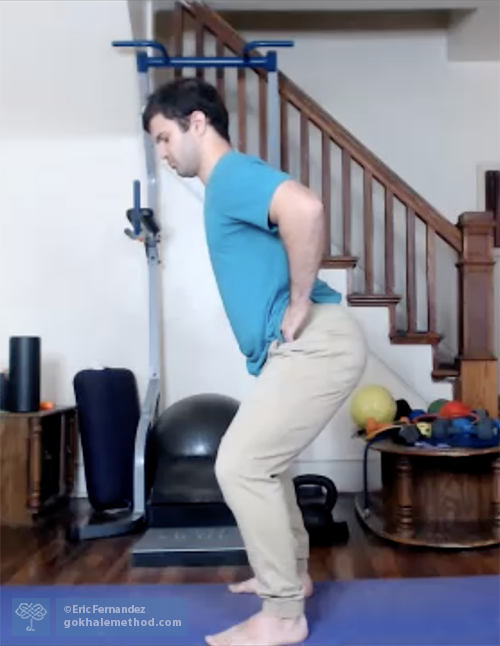
A healthy squat embodies all the points above.
- When you are confident with the above you can raise your arms smoothly as you squat. Maintain your rib anchor, especially if you have stiff shoulders and are more likely to sway to lift your arms. If possible, bring your arms to the same angle as your torso.
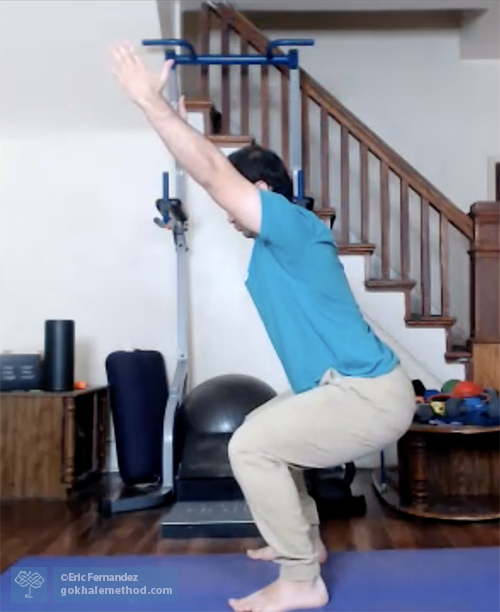
Raising your arms in line with your torso requires a strong rib anchor to prevent your back from swaying.
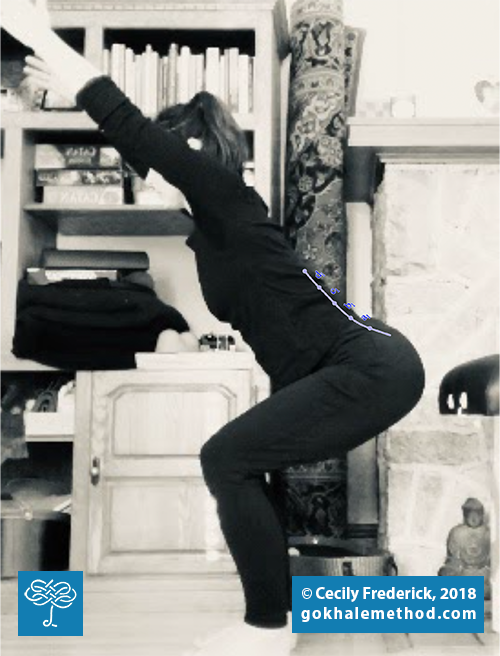
Gokhale Method teacher Cecily Frederick in Chair Pose, overlaid with SpineTracker™ snapshot. The SpineTracker gives real time feedback on the shape of the spine. Note that Cecily’s spine remains straight in the lumbar area and the J-shaped angle at the L5-S1 junction puts her behind behind her—she does not arch her back.
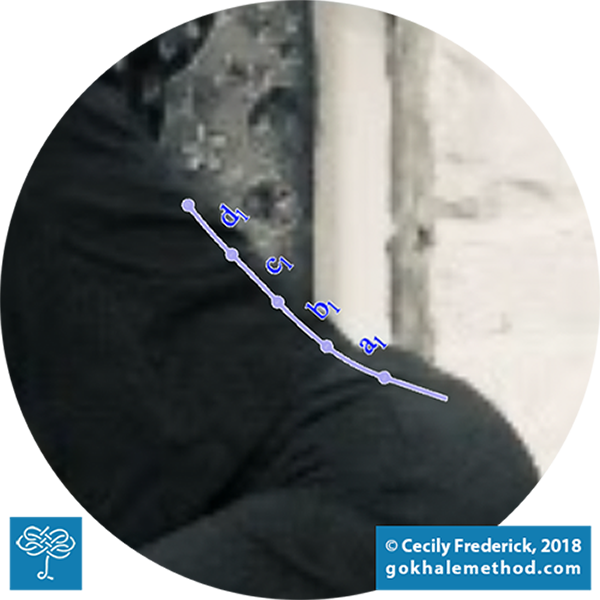
Detail of Cecily Frederick’s spinal shape in Chair Pose, overlaid with SpineTracker snapshot.
Common Mistakes:
- Swaying the back. Fix this by using your rib anchor to remove the sway.
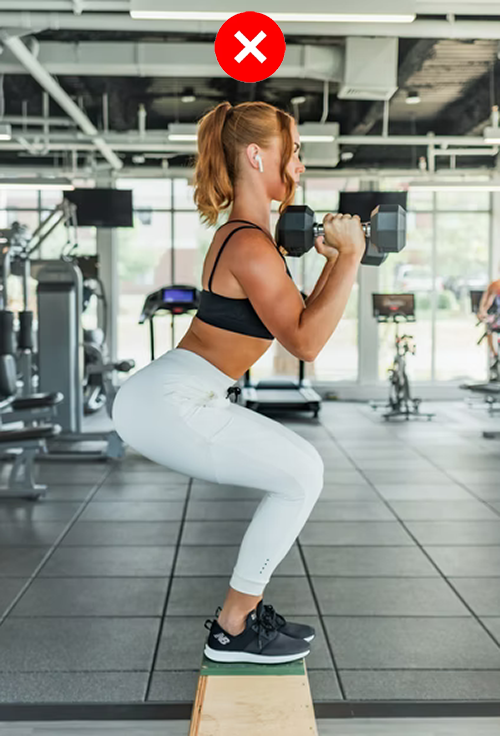
Swaying the back compresses the lumbar discs and nerves. Unsplash
- Knees and/or feet collapsing inward. Fix this by angling your feet outward.
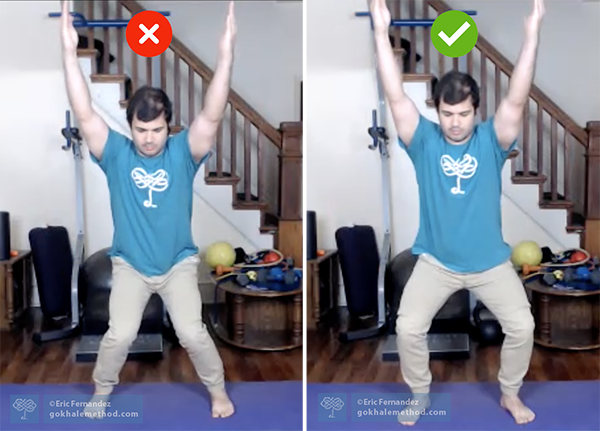
Internal rotation of the legs (left) puts pressure on the inner knees and flattens the foot arches. Feet turned outward and knees and thighs kept wide helps support your structure while allowing the pelvis to settle.
- Lifting the chin. Avoid looking up or ahead. Fix this by softening your gaze and aligning your head and neck with the rest of your torso.
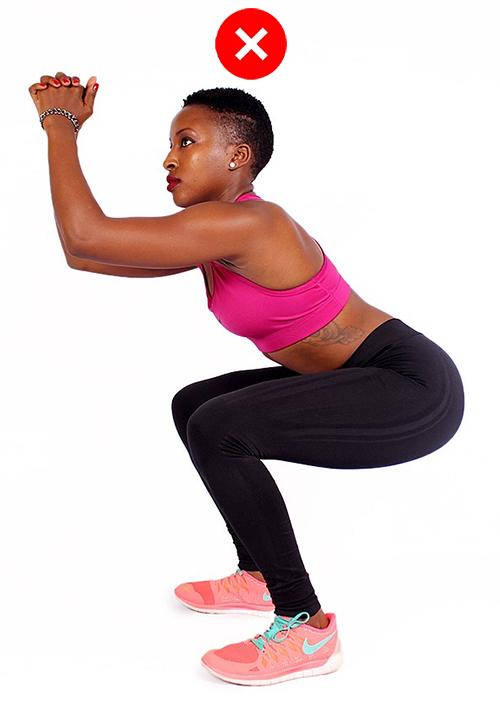
Lifting the chin risks putting pressure on the discs and nerves of the cervical spine. It is better to cultivate a long, tall neck. Wikimedia
4. Increasing the challenge in squat
Once you have good technique and can perform squats smoothly with good form, you can increase their intensity in several ways—though not all at once!
- Increase the number of reps.
- Go deeper—take your thighs towards horizontal. Make sure your torso also pivots closer towards your thighs, your behind stays behind, and your knees do not go forward of your toes.
- Hold a squat position for a number of breaths. Maintain a strong rib anchor so as not to flare the ribs and sway with each inhalation.
Free Online Workshops
If you would like to find out more about how the Gokhale Method can help support you, whether through exercise or posture education, sign up to join one of Esther’s upcoming FREE Online Workshops.

Comments
First, can my username be
First, can my username be changed? i'd prefer photonanny or pavanbrooke
Second, in BKS Iyengar in Utkatasana photo notice how his knees are way out in front of his toes? I've always heard your knees should not be in front of the toes. And the current example with Eric, his knees are even with his toes. Can our toes be ahead of your knees as long as your back in the right curve and butt outhinged correctly?
Thank you for all that you do.
Hi there!On the topic SQUAT i
Hi there!
On the topic SQUAT i have a question for Eric, all the teachers, practicioners and Esther itself: do you ever encountered the work of the "Knees over toes guy" on youtube or in person? What do you think about his technique to strenghten the knee joints and his squat style?
you can find some information here:
https://www.atgonlinecoaching.com
I'm seriously sceptical about the long term benefits of this kind of exercises, but he report a lot of succes stories and i'm really curious about your opinion!
Thank you!
Add New Comment
Login to add commment
Login